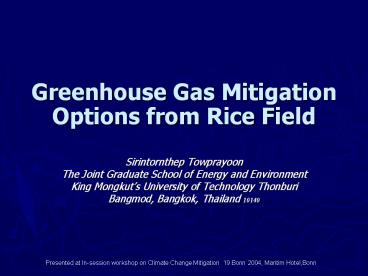Greenhouse Gas Mitigation Options from Rice Field PowerPoint PPT Presentation
Title: Greenhouse Gas Mitigation Options from Rice Field
1
Greenhouse Gas Mitigation Options from Rice Field
- Sirintornthep Towprayoon
- The Joint Graduate School of Energy and
Environment - King Mongkuts University of Technology Thonburi
- Bangmod, Bangkok, Thailand 10140
Presented at In-session workshop on Climate
Change Mitigation 19 Bonn 2004, Maritim
Hotel,Bonn
2
Background
- Rice fields contribute approximately 9-13 percent
of the global greenhouse gases - Methane and nitrous oxide are the dominant GHG
emission
3
Mechanism
- To implement mitigation options need well
understanding of the emission mechanisms - Interaction between rice plant, microbe, the
environmental condition in the soil, and the
cultural condition of the farmer - Methane produced by methanogen under anaerobic
condition in the rice field - Nitrous oxide produced by nitrifying and
denitrifying bacteria under the anoxic condition - Rice plant, during reproductive growth excrete
some essential nutrient and activated microbial
growth
4
Denier van der Gon, 1996.
5
Growth and development
Height, mass,density
Rice varieties
Emission
Production
soil properties
Root exudates
Indigenous Microorganisms
6
Height, mass,density
Rice varieties
Emission
Production
Anaerobic and anoxic condition
Indigenous Microorganisms
7
Mitigation options
- Factor affecting GHG emission
- Land preparation
- Seed preparation
- Rice varieties
- Fertilizer application
- Water management
- Harvesting and fallow period
8
Land preparation
Dry land level
Wet land level
9
Plowing
10
Seed preparation
Direct seeding
Pre-germinated seed and seedlings
Transplanting or Casting
11
Harvesting
12
The choice of mitigation options
- Ultimate goal High yield and GHGs reduction
- Economic aspect
- Low cost investment, labor, machinery
- Market positive expandable market, good price
- Governmental subsidy
- Social aspect
- Acceptable by farmers
- Easy to implement
- Undisturbed farmer way of life
13
Impact of mitigation options on rice cultivation
Mitigation options GHG reduction Increased investment Increase Labor cost Influence cultural practice Easy to implement
Land preparation Yes yes Yes/no yes no
Seedling practice Not clear no yes yes no
Rice varieties Not clear yes no no yes
Fertilizer Application yes yes/no no no yes
Water Management yes no no no yes
14
Options chosen
- Water management
- Reduce GHG
- Economic not involved with investment
- Easy to implement and being accepted by farmer
- Shifting fertilizer application
- Reduce GHG
- Economic less invesment
15
Options of water management
- In common practice, water was drained out of the
field during vegetative period. - Drainage reduce methane but promote nitrous oxide
- Shifting drainage time from vegetative period to
reproductive period help reduce methane
production and emission - Shorten drainage day also help reduce nitrous
oxide emission
16
Methane emission and soil redox potential from
4 different drainage rice fields
17
Nitrous oxide and methane emission from 4
different drainage rice fields
18
Comparison to local method
Net GHGs Methane Emission Nitrous oxide Emission Grain yield
Mid season drainage lt25.86 lt27.52 gt55.5 lt6.86
Multiple Drainage lt33.53 lt34.55 gt16.47 lt11.43
19
Yield and GHG Emission
- Area of irrigated rice field (local practice) is
3 times greater than area of rain fed rice field
( continuous flooding) - Three scenarios have been set up
- Continuous flooding and local practice (base
case) - Continuous flooding and midseason drainage
- Continuous flooding and multiple drainage
- All midseason drainage
20
Estimated economic comparison
Scenarios Total GWP (million tons CO2 equivalent) Yield ( million tons/year) Local Price (million Baht/year ) World market Price (million US)
Base case 54.4 45.6 341,678 10,706
Continuous Midseason 50.0(4.4) 44.6 334,310 10,475(231)
Continuous Multiple 48.7(5.7) 43.9 329,384 10,320(386)
All Midseason 39.8(14.6) 42.6 319,519 10,011(695)
21
Option of fertilizer application
- Two time of fertilizer application basal
fertilizer and top dressing fertilizer - In general, urea is use as the common fertilizer
- Ammonium sulphate (inhibit methanogen) and
ammonium phosphate ( promote rice plant growth )
was applied in substitute to urea
22
Economic comparison
Scenarios Total GWP (million tons CO2 equivalent) Yield ( million tons/year) Local Price (million Baht/year ) World market Price (million US)
Base case 26.7 50.6 379,651 11,891
Ammonium sulphate 22.5(4.2) 48.5 364,352 11,397(494)
Ammonium phosphate 21.6(5.1) 49.0 367.547 11,515(376)
No fertilizer 20.6(6.1) 34.7 260,110 8,154(3737)
23
Reduction and trading
Percentage of GHG reduction Amount of GHG Reduction (Million tons CO2 equivalent) Percentage of trading price reduction Range of trading price reduction (Million US)
Water management 8-27 4.4-14.6 2-6 231-695
Fertilizer application 16-23 4.2-6.1 3-30 494-3737
24
Conclusion(1)
- GHG emission from rice field is survival
emission - The implementation need to be carefully
considered - The options should not impact on the farmers way
of life as well as theirs investment but should
promote theirs income
25
Conclusion(2)
- Aprox. 25 percent of GHG reduction could achieve
in comparison to base case - Options to reduce GHGs impact on rice yield
- Optimizing between GHG reduction and yield need
to be concerned
26
Acknowledgement
- Thailand research fund
- Ms. Saipin Poonkaew and Ms. Kruamas Smaghan
27
Thank you for your attention

